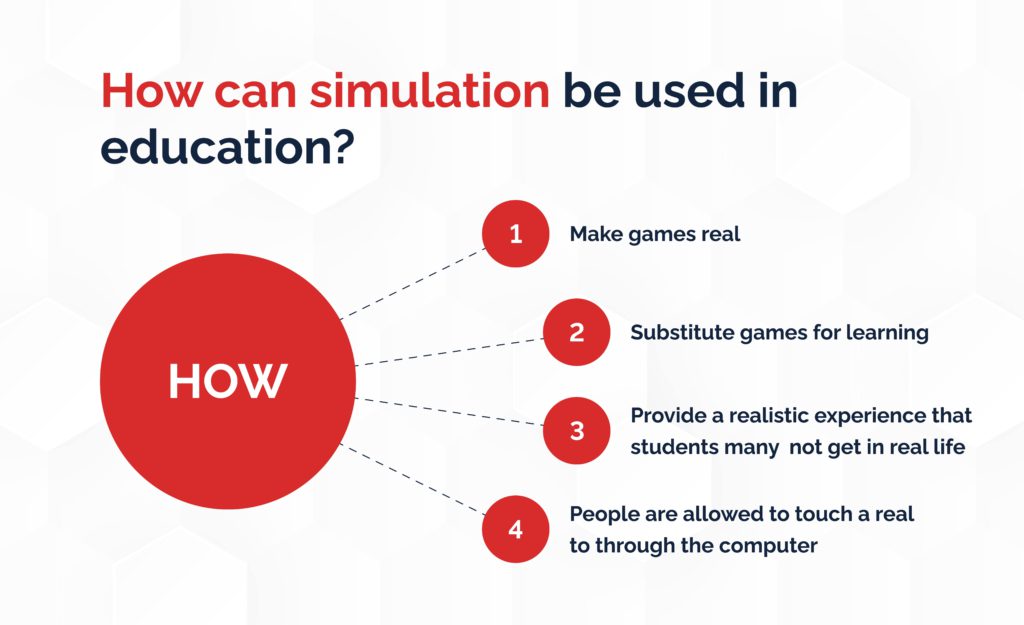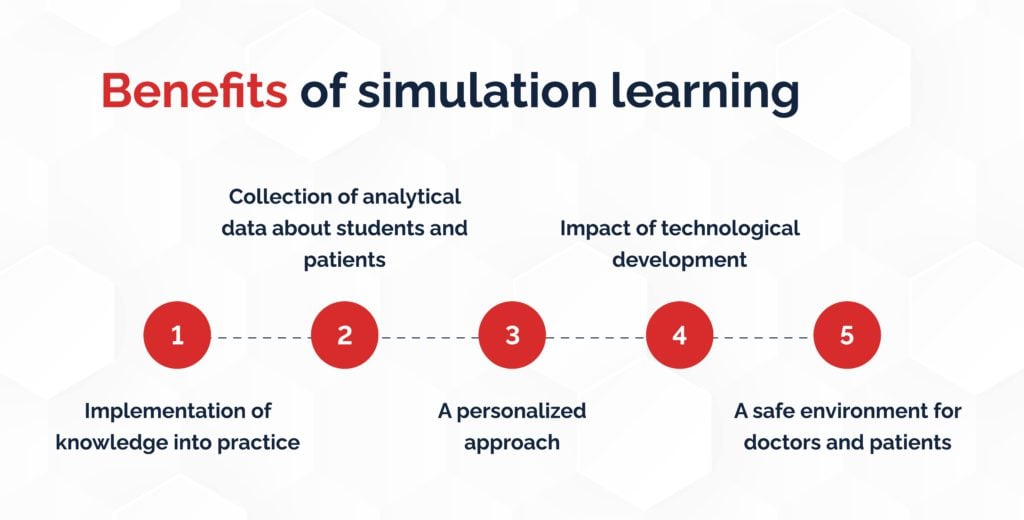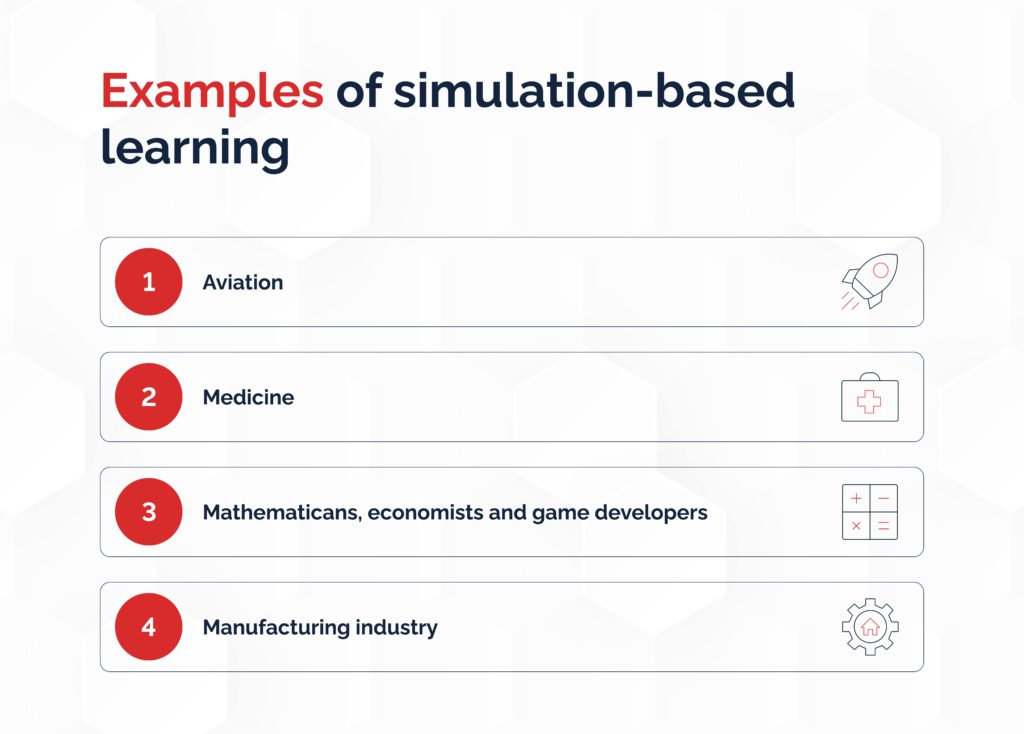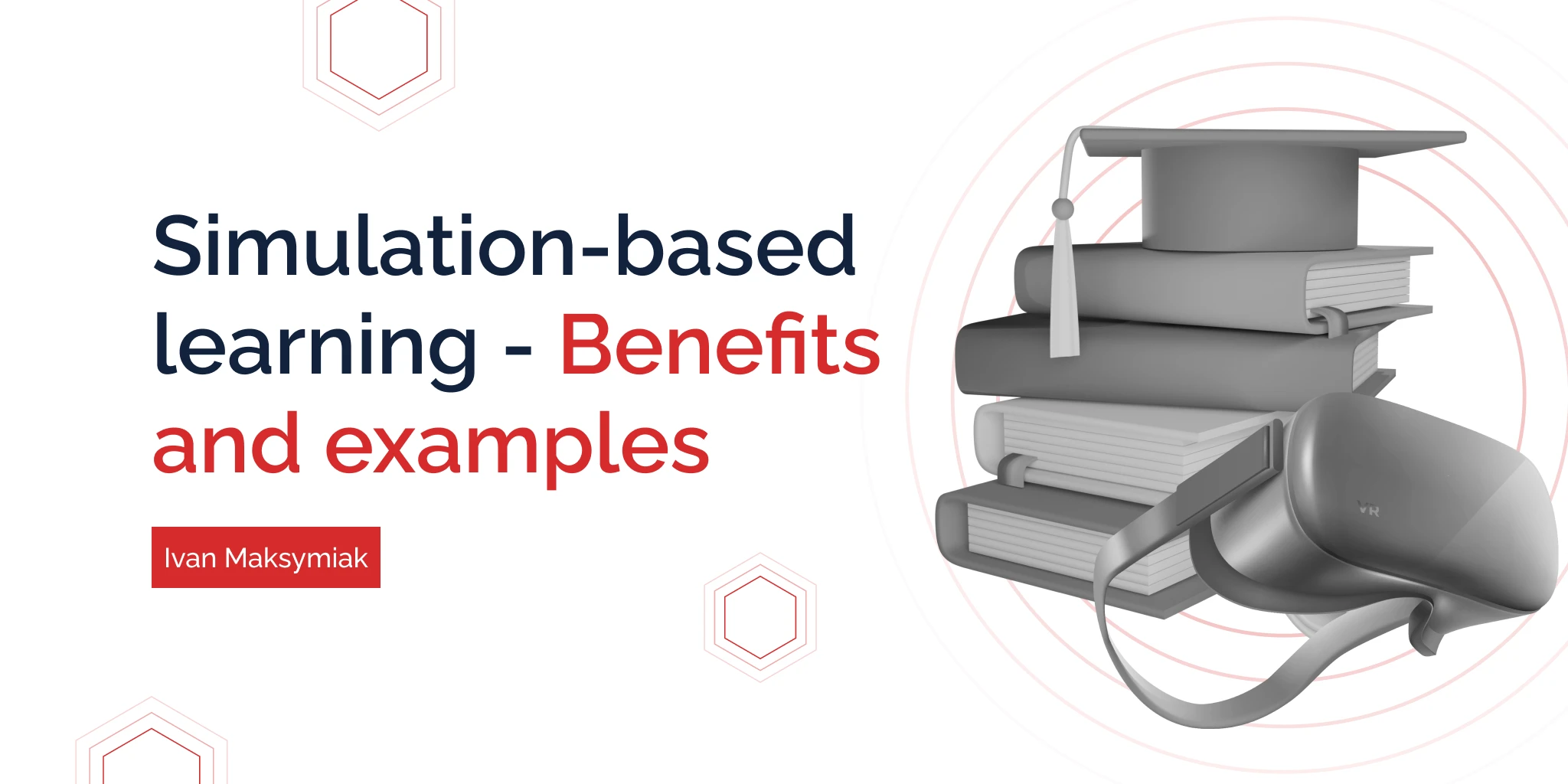Our expert team will tell you about achieving the desired result through simulation learning.
The study will also highlight the specificity of simulation-based learning in education, which is essential for the learning environment. The experts will provide information about testing simulated scenarios and mastering various virtual technologies.
What Is Simulation Learning?
The definition of simulation-based learning highlights the integration of simulation with a real or virtual person, object, or equipment. It provides opportunities to coordinate this cooperation through the decisions and actions of students.
Simulation e-learning is a good option for learning a wide range of complex skills in higher education. It also ensures different types of background knowledge to facilitate effective learning. Technologies and frameworks always have a positive effect on learning. Based on previously acquired knowledge, students benefit mainly from the reflection phases. Students with limited skills learn better if provided with realistic everyday scenarios.
The simulation demonstrates the interaction of games and virtual objects with real users. Educational simulations also embody the benefits of critical thinking and problem-solving during learning. This simulation in education also applies to students’ active role in developing their skill levels.
How Can Simulation Be Used in Education?
A critical question arises how can simulation be used in education with all its features. Simulations have many functions to solve essential situations in an actual situation. For example, simulations may use assistive technology to reflect reality better or provide more opportunities for practice or learning.

The importance of simulation in education always lies in recreating realistic situations and natural interactions in which participants can participate. Simulation can be conceptualized as a simplified version of the practice in education. Further, it attracts newcomers to practice that is close to the profession. The authenticity and validity of simulation in education determine the educational environment’s realism level. These factors also include the extent of the students’ involvement in it. In this discourse, exploring the benefits of the LMS for Schools and Colleges is crucial.
Benefits of Simulation Learning
The importance of simulation in education always lies in recreating realistic situations and natural interactions in which participants can participate. Simulation can be conceptualized as a simplified version of the practice in education. Further, it attracts newcomers to practice that is close to the profession. The authenticity and validity of simulation in education determine the educational environment’s realism level. These factors also include the extent of the students’ involvement in it. In this discourse, exploring the benefits of the LMS for Schools and Colleges is crucial.

◼ Improved engagement and knowledge retention
Simulation-based learning is notable for a crucial feature: it offers higher engagement and better knowledge retention rates. Firstly, simulation-based training disrupts the common complaint raised against traditional education. It’s very practical and down-to-earth in comparison to the more theoretical traditional training methods. People who encounter theoretical learning get an opportunity to try out their knowledge in a controlled environment that is close to real life. Secondly, it also improves knowledge retention. One of the biggest problems with modern education is that it primarily focuses on disconnected knowledge that is presented in an order that seems logical to a teacher. Scenario-based training goes against this trend by allowing the students or future employees to make their connections regarding learning. By applying knowledge to real-life scenarios, every person gets an opportunity to create their mnemonic patterns for memorizing the core learning material.
◼ Implementation of knowledge into practice
Imagine, simulation in healthcare education with virtual or real patients helps students learn to make significant and quick decisions. Such decisions must be made under different circumstances, especially when the patient has additional complications. For example, simulation prevents putting patients at risk by performing daily simulation exercises.
◼ Collection of analytical data about students and patients
Another benefit of simulation in medical education is the ability to collect measurable data about students and patients. In simulation training, the expert determines the scenario parameters and contains a history of the simulation progress of students and patients. You can monitor the decision-making process and their simulation valid for specific actions. Then it’s easy to determine which technical skills need further training and how inexperienced the participants are. This plan protects unprepared students and potential patients from risky situations outside of the simulation in a natural environment.
◼ A personalized approach
It’s essential to learn from your mistakes, critically evaluate your work, and periodically compare it with previous performance assessments. Then you will strive for broader and deeper learning. Everyone has different needs, and cross-faculty simulation models guarantee the most appropriate training based on individual criteria.
◼ Impact of technological development
Modern technology advances effectively integrate simulation into training systems. They demonstrate web-based simulations that personalize employee learning, especially with simulation devices.You can also Сreate an Educational App and add all the features you need and monetize it later.
◼ A safe environment for doctors and patients
If students practicing on mannequins make mistakes in their treatment process, it doesn’t negatively affect the natural person. Then a more experienced expert can advise a plan of action and choose the training simulations individually. Mistakes in modeling will develop confidence in making the right decisions independently in other real-life situations.
◼ High accessibility
Simulation-based learning programs have one more significant positive. They’re much more accessible than traditional education. At first glance, this insight may seem counterintuitive. Why? After all, many people think that simulations require you to be present in a certain location and do particular actions to maximize skill development. However, the spread of virtual reality changed this trend once and for all. It’s now possible to create a safe learning environment even for jobs that involve somewhat dangerous conditions. You can fully recreate certain work sets in training programs through the use of three-dimensional virtual reality tools.
Why is this ultimately so vital? Primarily, one can train people from any location in the world, improving learning outcomes across, for example, multiple divisions of your company. Secondly, you also can test scenarios that are highly unlikely to manifest in real life. For example, it’s possible to try out multiple emergencies for healthcare training with the help of virtual reality. In short, learning becomes much more accessible with the use of these technologies.
◼ Effective use of costs
Advantages of simulation spread beyond learning outcomes. What are some other positives of the presented technology for the learners in real-world scenarios? It greatly saves costs for all stakeholders, giving a competitive advantage both to firms and employees. The first positive impact comes in the form of reduced expenditures for the recreation of real-world scenarios. Many sets in, for example, military training require millions or even tens of millions of dollars for their creation. As a result, military organizations often get only one chance to train their members in large-scale events over multiple years.
Virtual reality allows various organizations to test the most complex scenarios at a minimum cost. A mining company can review highly dangerous events in a virtual environment without having to create complex training sets in real life. Similarly, a major positive impact concerns the learners, too. What are the benefits they get? In this respect, the average learner receives an opportunity to save money on traveling to training locations. Moreover, they can get hands-on experiences at minimum costs.
◼ Improved sustainability
Lastly, the presented tools are perfect for improving sustainability for the majority of firms. As we’ve mentioned before, traditional methods require complex sets to guarantee immersive experiences. These traditional methods often have significant real-world consequences. Large disaster trainings consume tremendous amounts of electrical energy. To make conditions realistic, they may also require some coal, gas, or oil emissions. Regarding healthcare professionals, some realistic scenarios may lead to significant waste of hard-to-recycle materials such as rubber. Combined, all those training events ultimately may have a very significant negative impact on the environment. Consequently, an effective tool in the form of virtual reality simulations solves this problem once and for all. You can create any complex environment for business learning or school training and test it through the existing tools.
Main Types of Simulation in Education
Simulation of an objective process requires using defined types of modeling based on the essential characteristics or behavior. Based on common types of modeling, the following can be structured:
◉ Problem-solving simulator.
The student is allowed to solve a new problem in different ways while using any simulation methods or processes.
◉ Social simulator.
When a student enters a natural environment, he must adapt to it and interact with its components. The environment can change due to the student’s decisions and actions.
◉ Software simulator.
This type of simulation is characterized by informative software features, simulation-based assessment, and effective use.
◉ Physical procedures simulator.
Due to its functionality, a simulation object is considered an actual physical device. Equipment or mechanisms are operated here.
◉ Operational simulator.
To achieve the desired goals of simulation, general procedures are performed on the basis of software or objects.
In addition, there are three more general types of simulation in education:
⇢ live simulations
Live people apply the latest real and virtual technologies in a natural environment and time. For example, doctors use a simulated mannequin to resuscitate a potential patient.
⇢ virtual simulations
The difference is based on changing the natural environment to a virtual world, such as a role-playing game or a product simulation. This type is characterized by the participation of real people and a programmed climate in simulated time.
⇢ constructive simulations
In this case, artificial intelligence completely dominates because people and the environment are simulated.
Examples of Simulation-Based Learning

There are multiple high-value applications for simulation-based learning in the modern world that are likely to have a very positive impact on the future of learning. Let’s review them and see what impacts are present.
Application in healthcare
Simulation-based learning is a perfect tool for various healthcare-based scenarios. For example, you can use it to simulate various surgeries or the management of emergencies among medical students. This approach promotes accessible learning among the students by allowing them to try out cases that are typically extremely rare in learning scenarios.
Application in aviation
The aviation field is notable for the complexity of the equipment that is being used in it. Consequently, it requires quite significant investments in training. Many aviation companies create very complex simulators to ensure that their pilots learn the best practices. In this regard, virtual reality and simple game-like tools are a strong way to minimize expenditures on this aspect of training.
Application in military and defense
The core problem with military simulation scenarios is that they are very expensive to recreate. Thousands of troops and dozens of vehicles are needed to prepare for a massive offensive or defensive operation training. More importantly, you’ll need many supplies to perform full-scale training operations. Modern simulations allow you to do all these actions in a well-prepared virtual environment that minimizes costs.
Application in business
Businesses can also benefit from the technologies that bring about the future of learning. Many business operations require some unique actions. For example, the management of an archive with financial documents may involve some specific security-oriented actions. Simulation-based learning is a perfect tool for trying them out in a safe environment at a minimum cost and without disrupting the workflow of other individuals.
Application to emergency response
The core application of the presented technology undoubtedly occurs in emergency response. In this respect, technology is essential for trying out complex situations that are difficult to recreate in real life. You can use it to, for example, test the readiness of your team to tackle challenges such as floods. As a result, we’re likely to see even more applications of simulation technology among emergency response operators.
Application to manufacturing
The last type of application includes the manufacturing industry. Manufacturing is highly notable for complex manual operations that require a lot of expertise from the workers. Therefore, they can benefit from simulations. Firstly, expertise can be promoted among multiple individuals with these core methods. Secondly, a vital positive factor is an opportunity to prevent possible equipment failures that may stem from their unskilled use. In this light, many firms are likely to be willing to use such tools due to their opportunity to save significant costs for them.
Key Signs of a Successful Simulation Development Company
When hiring a company to develop simulation tools, you should look for the following features:
1) Significant experience in general development: the first aspect we recommend looking at is the general experience in development. Why is this the case? When the developers of a particular company have experience working on multiple projects, they typically become much more flexible in terms of knowledge and skills. As a result, their chances of adapting to diverse requirements in the education sector improve significantly.
2) Major knowledge of education and simulation-based sectors: another important aspect is the experience of developers in your particular field. In this regard, we recommend searching for experts who at least have worked with education. Simulation and virtual reality knowledge are an especially important aspect to consider. Try to search for companies that have genuinely developed some digital simulation tools for their customers.
3) Advanced knowledge of UI/UX: high-value learning experiences often greatly depend on the quality of user interface and experience. In this respect, VR is especially difficult to configure. Hence, you should look for companies that have extensive experience in developing user interfaces. One should have experience both in VR and web/app development to guarantee high-quality outcomes for the learners.
Impact of Virtual and Augmented Learning on Simulation-Based Learning
Simulations can be created in two ways. Firstly, you can try to develop a video-game-like environment in which the users will have an opportunity to try out certain actions. This approach is the most common one as it’s the cheapest. Many manufacturing organizations are using simulations of this type to create a realistic environment for learners. Secondly, it’s now possible to use virtual or augmented reality to promote simulation-based learning.
How exactly can they be used? You can create similar video-game-like environments, but then use virtual reality tools to make them much more interactive. For example, your learners will have an opportunity to perform the majority of actions, such as emergency medical care, accurately. Modern VR has sufficient tracking capabilities to simulate even the most precise actions in surgery. In the end, this means that virtual and augmented reality is going to make computer-based simulations much more realistic in the upcoming years.
The Future of Simulation-Based Learning in Education
Simulation-based learning in education will first of all focus on technological progress. Such achievements are especially significant in healthcare, which will constantly improve its level. Education through advances in simulation technology will have a significant impact on the training and education of medical personnel.
Simulation-based learning has already taken over some industries, and the trend is moving fast. Newly education software development will still require human feedback and interaction. As machines replace humans in high-pressure situations, their ability will be critical. Delivery services are starting to use drones. The military infantry already conducts its training in a simulated environment. Practicality and economic benefits are also manifested in using crewless aerial vehicles and modern weapons on a large scale.
It can be predicted that with the development of advanced technologies, simulation tools in education will be a crucial part of today’s innovative world.
Conclusion
Simulations provide comprehensive skill practice and offer learning environment design in education. Although expert analysis shows that social skills aren’t too advanced, their technical acquisition may soon be significantly developed.
Contact our services to explore simulation-based learning environment design.
Simulations in education improve the learning quality and provide a positive experimental environment. Keenethics will help you understand which variables guarantee effective system performance.












